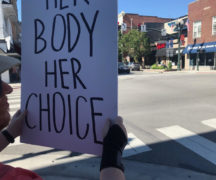BY SUSAN TEBBEN
Abortion rights groups preparing to put a constitutional amendment on the Ohio ballot released the proposed language Tuesday, the same day they sent it to the state Attorney General’s Office for review.
Ohio Physicians for Reproductive Rights and Ohioans for Reproductive Freedom will now await approval of the amendment, starting the signature collection process to bring the amendment to voters in November.
The measure would amend Article 1 of the Ohio Constitution to add “the right to reproductive freedom with protections for health and safety,” according to the draft language.
“Every individual has a right to make and carry out one’s own reproductive decisions, including but not limited to decisions on contraception, fertility treatment, continuing one’s own pregnancy, miscarriage care and abortion,” the proposed amendment states.
Legislative measures to prohibit abortion aren’t out of the question, even if the amendment is passed by voters. The draft language allows for abortion “after fetal viability,” which abortion rights group acknowledge is a definition under much debate.
“But in no case may such an abortion be prohibited if in the professional judgment of the pregnant patient’s treating physician it is necessary to protect the pregnant patient’s life or health,” according to the proposed amendment.
In drafting the proposal, Dr. Lauren Beene, executive director of OPRR, said they are working under the idea that fetal viability is “the point in which the fetus could survive outside of the pregnant person without unreasonable or extraordinary measure being taken.”
The main goal of the amendment is to bring reproductive decisions out of the statehouse and back to the patient and their doctor, on a case-by-case basis, and to set them in verified medical science, rather than ideology.
“Today, this is how we can help people and how we can restore the medical capabilities that we used to have by enshrining that in our (state) constitution,” said Dr. Marcela Azevedo, of OPRF, in a press call announcing the proposal language.
Though the state has seen various pieces of legislation proposed to regulate abortion, and a six-week abortion ban implemented after the fall of Roe v. Wade was paused indefinitely by a Hamilton County judge, it’s time to lift the issue out of the halls of government, abortion rights advocates say.
“We simply can not rely on our legislators or even ultimately on our courts to secure this freedom in the long run,” said Jessie Hill, an attorney and law professor who worked with ORF on drafting the language.
The amendment proposal also says the state “shall not, directly or indirectly, burden, penalize, prohibit, interfere with, or discriminate against” individual exercising the reproductive rights laid out in the amendment.
“It’s really about the government having to back up the idea that something promotes health and safety,” Hill said.
Anti-abortion rights groups immediately spoke out against the ballot initiative, with Ohio Right to Life calling the language “extremely vague, making it even more dangerous than we originally believed it would be.”
Religious lobby Center for Christian Virtue claimed the ballot measure would “eliminate the basic rights of parents who would no longer need to be informed or provide consent for their minor daughter to have an abortion,” something the proposed amendment drafters said is not a part of the language.
The language released to the media does not mention parental consent or abortion care for minors specifically.
Current state law requires parental consent for an abortion if the pregnant person is younger than 18, but a legal method called“judicial bypass” exists, which would allow minors to pursue abortion care if they can prove to a judge that they can decide intelligently and are “sufficiently mature” enough to consent to an abortion.
Attorney General Dave Yost’s office now has 10 days to approve the amendment summary and certify it for the Ohio Ballot Board.
Should that happen, the ballot board then has 10 days to make sure the language only applies to one constitutional amendment, before it’s sent on the Ohio Secretary of State.
After the proposal moves through the official channels, groups can then collect signatures. In order to lecvalidate the petition, more than 413,000 Ohioans must sign, and signatures must be collected from at least 44 of the state’s 88 counties.
The deadline for signature collection is July 5.
The effort will not be cheap. Beene estimated that collecting the needed signatures across the state could cost from $2 million to $6 million, and the campaign to persuade voters to approve the initiative could take $20 to $30 million.
Also from Ohio Capital Journal:





